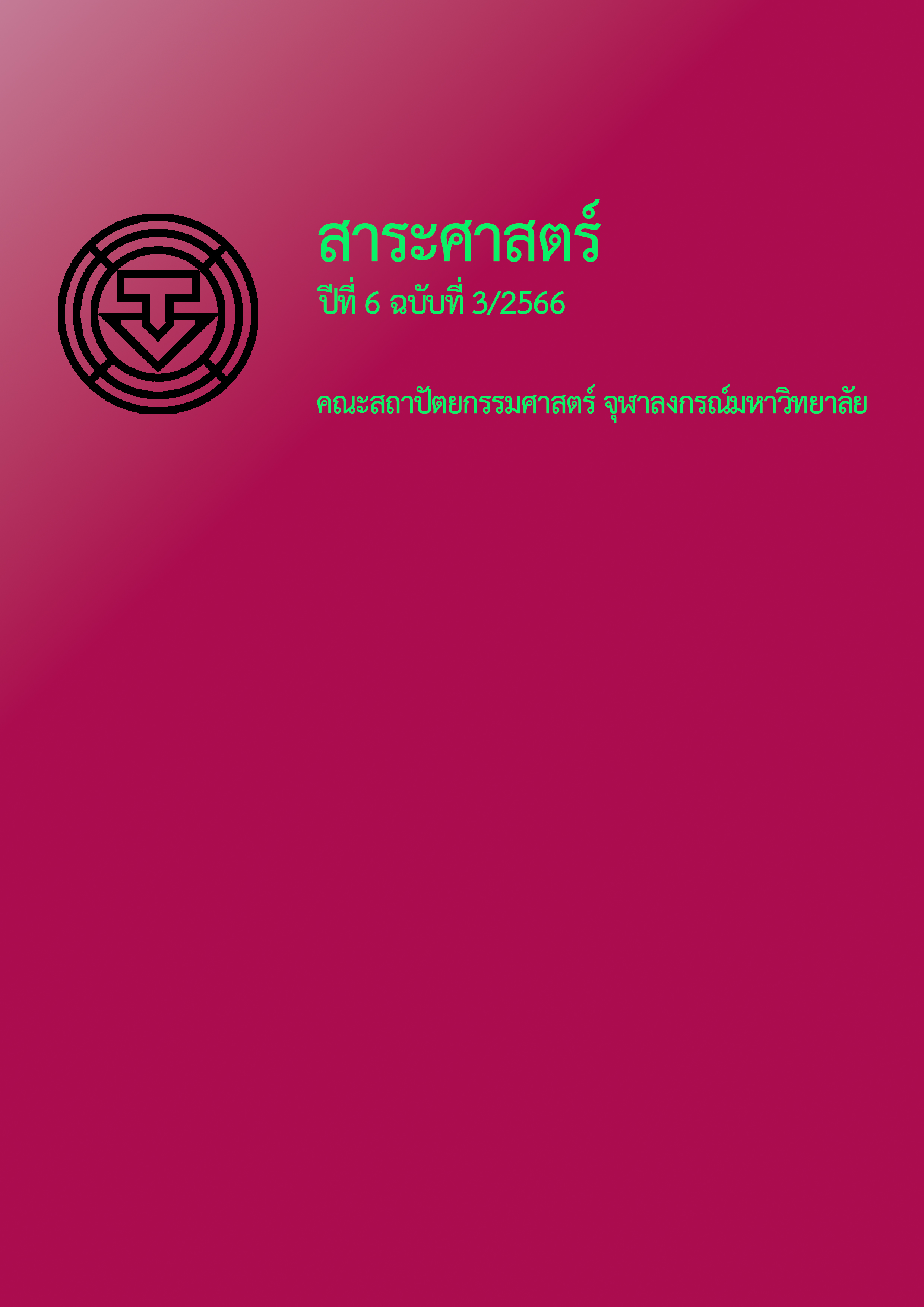The Changes of Housing Condition of a Relocation from under Bridge Community to a Rewarded Community : Case of Onnut 14 Rai Community
Main Article Content
Abstract
On Nut 14 Rai Community is a model community for waste management that received an 'Outstanding Model Saleng Community' Award. With 'Zero Baht Shop' as a driver to solve the economic and social problems in the community until the success has been acknowledged outside. In the past, the community used to be a trespassing community under the bridge. The housing conditions are insecure and unhygienic. At August 10, 1993, the Government of Thailand decided to solve the housing problem of the under-bridge communities in Bangkok. The National Housing Authority and the Bangkok Metropolitan Administration have jointly implemented the project with the Habitat Development Foundation, with the process of relocating the community to a new place with participation. Dividing the new area into three areas, one of which is On Nut 14 Rai Community.
At present, housing in the community has been developed with participation for 22 years. The community has developed until it has received awards. Feedback study on habitat change are therefore important. The objectives of the study were 1) to study the change of housing conditions in the On Nut 14 Rai community from the period of relocation to the present; 2) to study factors affecting the change of housing conditions and current housing conditions problems; and 3) to suggest guidelines for community development and housing conditions.
The results of the study of nine sample cases found that 1) Regarding the change of housing conditions in On Nut 14 Rai community from the period of resettlement to the present, it was found to the sample cases had 22.2 percent of very good change of housing conditions, 55.3 percent of the condition improved, and 22.2 percent of the condition worsened. 2) For factors that cause change of housing conditions, 2.1) Factors that improve housing conditions: the top 3 most common are increase of demand for living space, Good occupation and environment, and the number of members increased and elderly are raised by offsprings. 2.2) Economic and social factors of the household are the main factors that improve housing conditions. 2.3) Community Award Factor: it affects only 1 in 24 cases. 3) For the present housing conditions problems: it was found that although most houses have changed for the better, they have also encountered problems with housing conditions. There are 36% of the houses deteriorated, 32% had environment problems, 27% had hygiene problems, and 5% had usable space problems. There should be housing development, leading to 1) suggestions to the community. To organize a community housing cooperative to improve the house and self-developing home improvement skills. 2) Suggestions to government agencies. The community development process should include the physical housing development process in parallel. There should be supports of career and income that are consistent and promote knowledge of minimum standards and good hygiene in housing.
Article Details
References
กฎกระทรวง ว่าด้วยการยกเว้นผ่อนผัน หรือกำหนดเงื่อนไข ในการปฏิบัติตามกฎหมายว่าด้วยการควบคุมอาคารสำหรับอาคารใน โครงการที่รัฐจัดให้มีหรือพัฒนาเป็นที่อยู่สำหรับผู้มีรายได้น้อย พ.ศ.2554. (2554, 14 มกราคม). ราชกิจจานุเบกษา. เล่ม 128 ตอนที่ 2 ก. หน้า 1-9. https://web.codi.or.th/printing_media/20151022-9450/
กรทิพย์ พฤกษ์ประเสริฐดี. (2544). การก่อสร้างที่อยู่อาศัยของผู้ที่ย้ายจากชุมชนใต้สะพาน [วิทยานิพนธ์ปริญญามหาบัณฑิตไม่ได้ตีพิมพ์]. จุฬาลงกรณ์มหาวิทยาลัย.
กรณ์พงศ์ ทองศรี. (2552). ผลกระทบด้านเศรษฐกิจของรูปแบบการถือครองที่ดิน : กรณีศึกษาเปรียบเทียบบ้านมั่นคงชนบท ตำบลวังน้ำเขียว จังหวัดนครราชสีมาและบ้านมั่นคงชนบท ตำบลดอนยอจังหวัดนครนายก [วิทยานิพนธ์ปริญญามหาบัณฑิต ไม่ได้ตีพิมพ์]. จุฬาลงกรณ์มหาวิทยาลัย.
กระทรวงมหาดไทย. กรมการพัฒนาชุมชน. (2559). คู่มือการจัดเก็บข้อมูลความจำเป็นพื้นฐาน ปี 2560-2564. https://issuu.com/cdd_chiangrai/docs/bmn60_handbook
การเคหะแห่งชาติ. (2529). มาตรฐานที่อยู่อาศัยและสิ่งแวดล้อมการเคหะแห่งชาติ. กคช.
การเคหะแห่งชาติ. (2562). ชุมชนผู้มีรายได้น้อยปี 2562. กคช.
กุณฑลทิพย พาณิชภักดิ์, ฉันทัส เพียรธรรม, ศศิกุล อ่อนเฉวียง, และวันเพ็ญ สิริยงสวัสดิ์. (2543). แนวทางการจัดการที่อยู่อาศัยแก่ผู้ประสบปัญหาที่อยู่อาศัยตามโครงการพัฒนาที่อยู่อาศัยสำหรับผู้มีรายได้น้อยในกรุงเทพมหานคร. คณะสถาปัตยกรรมศาสตร์ จุฬาลงกรณ์มหาวิทยาลัย.
"คนรู" ผู้เป็นต้นแบบ - พีรธร เสนีย์วงศ์ - กับ "ร้านศูนย์บาท" ชีวิตใหม่ของคนไร้บ้าน. (2558, พฤษภาคม 26). หนังสือพิมพ์ผู้จัดการรายวัน. https://mgronline.com/onlinesection/detail/9580000058463
ทรงเดช ดารามาศ. (2537). บ้านใต้สะพานในเขตกรุงเทพมหานคร [วิทยานิพนธ์ปริญญามหาบัณฑิต ไม่ได้ตีพิมพ์]. จุฬาลงกรณ์มหาวิทยาลัย.
บรรณโศภิษฐ์ เมฆวิชัย, กุณฑลทิพย พานิชภักดิ์, บุษรา ศรีพานิชย์, ดรุณ นาคจำนง, พงษ์ศักดิ์ กังวานพาณิชย์, เอกชัย ชูสังข์, สุพินดา ตั้งรุ่งเรืองอยู่, เกรียงศักดิ์อ่าวอุดมพันธ์, ทิพวรรณ แสนจันทร์, และกานนท์ เทพคเชนทร์. (2547). มาตรฐานที่อยู่อาศัยสำหรับผู้มีรายได้น้อย. คณะสถาปัตยกรรมศาสตร์ จุฬาลงกรณ์มหาวิทยาลัย.
มูลนิธิการจัดการทรัพยากรอย่างยั่งยืน. (2562). ชุมชนอ่อนนุช 14 ไร่ กทม. http://www.3r-foundation.or.th/th/network/network3r/central/detail/156/
มูลนิธิพัฒนาที่อยู่อาศัย. (2546). คนใต้สะพาน. มูลนิธิ.
วลัยพร สายเสมา. (2560). จาก“คนเก็บขยะ”สู่“กลุ่มอาชีพซาเล้ง” : การสร้างการเปลี่ยนแปลงทางอัตลักษณ์กรณีศึกษาชุมชนอ่อนนุช 14 ไร่ เขตประเวศกรุงเทพมหานคร [วิทยานิพนธ์ปริญญามหาบัณฑิต ไม่ได้ตีพิมพ์].มหาวิทยาลัยธรรมศาสตร์.
ศุภชัย ถาวรสุภเจริญ. (2545). การใช้พื้นที่อยู่อาศัยของชุมชนที่ถูกรื้อย้ายจากบ้านใต้สะพานในกรุงเทพมหานคร [วิทยานิพนธ์ปริญญามหาบัณฑิต ไม่ได้ตีพิมพ์]. จุฬาลงกรณ์มหาวิทยาลัย.
สถาบันพัฒนาองค์กรชุมชน. (2562). บ้านมั่นคงชนบทและเมือง. https://web.codi.or.th/development_project/20190321-135/
สำนักงานเขตประเวศ. (2563). แผนพัฒนาชุมชนอ่อนนุช 14 ไร่ ประจำปี พ.ศ. 2563. สำนักงาน.
สินีนาฏ วงศ์สวัสดิ์. (2545). การเปลี่ยนแปลงวิถีชีวิตหลังการรื้อย้ายจากชุมชนใต้สะพาน [วิทยานิพนธ์ปริญญามหาบัณฑิต ไม่ได้ตีพิมพ์]. จุฬาลงกรณ์มหาวิทยาลัย.
SCG Circular way. (2563). ชุมชนอ่อนนุช 14 ไร่.https://www.scg.com/sustainability /circular-economy/global-thailand-practices/on-nut-14-rai-community/utm_source=FBSCG&utmmedium=Business_S368Onnut14&utm_campaign=
AlbumPost_CES368_171020_UPZ_&fbclid=IwAR1G54OoJvnRpZNwu6hyFS5QTCllR_eKxH3LANFzVTfCHpaKJEf6FWrpMA


